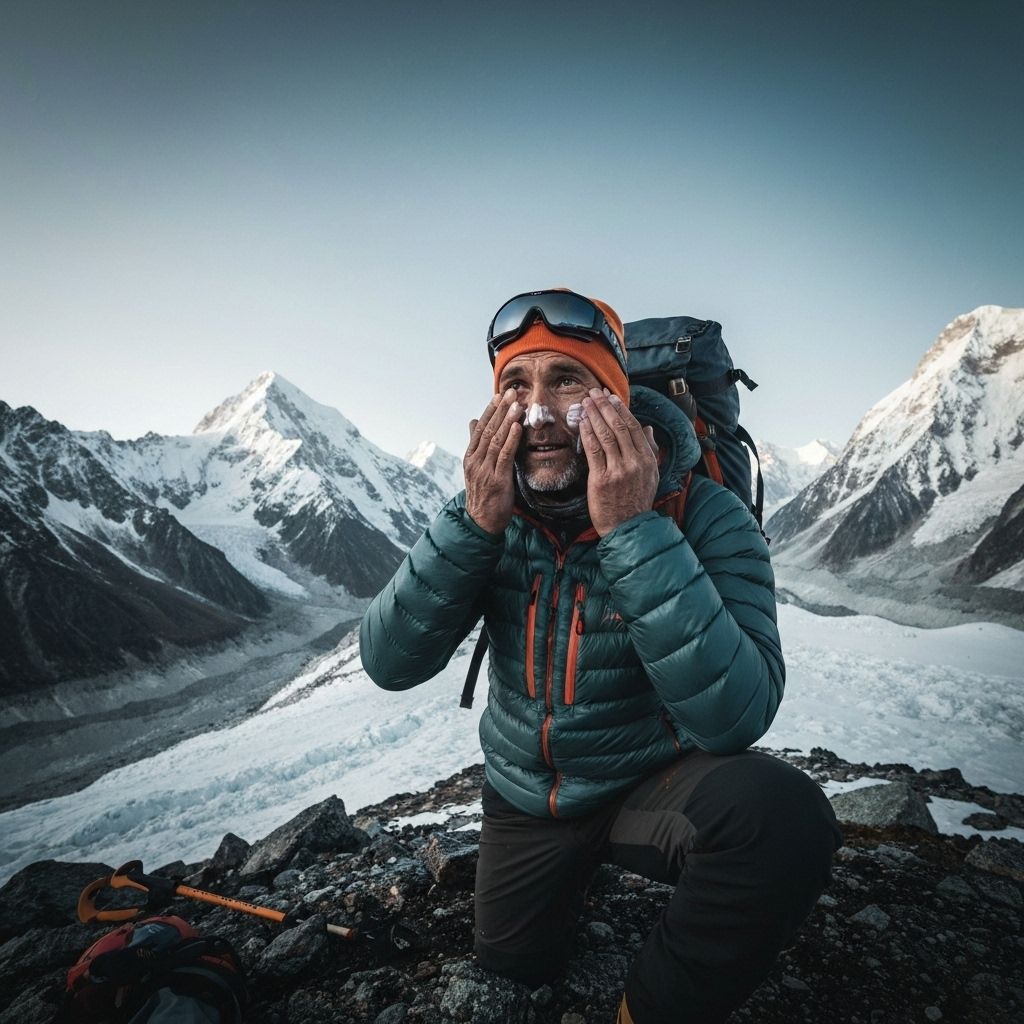Essential Skincare Guide for Mountain Expeditions

Planning a high-altitude expedition? Your gear list probably includes ropes, crampons, and warm layers – but have you thought about your skin? Here's everything you need to know about skincare for mountain expeditions.
Pre-Expedition Preparation
Start preparing your skin at least two weeks before your expedition. Focus on building a strong skin barrier by using a quality moisturizer daily. Avoid harsh exfoliants or new skincare products that might cause irritation – you want your skin in optimal condition before facing extreme conditions.
If you're prone to dry skin or eczema, consult with a dermatologist about prescription barrier creams. These can provide an extra layer of protection when you need it most. Also, ensure you're well-hydrated in the weeks leading up to your climb – internal hydration is just as important as external moisture.
Essential Products to Pack
High-SPF Moisturizer: This is non-negotiable. At altitude, UV radiation increases dramatically. Our Mountain Moisturizer with SPF 30 provides both hydration and sun protection in one product, saving precious pack weight.
Lip Balm with SPF: Your lips are particularly vulnerable to sun damage and chapping at altitude. Apply frequently throughout the day, especially before and after meals.
Hand Cream: Your hands take a beating from rope work, cold temperatures, and constant exposure. A rich, non-greasy hand cream is essential for maintaining dexterity and preventing painful cracks.
Daily Skincare Routine at Altitude
Morning: Apply moisturizer with SPF to your face, neck, and ears before leaving your tent. Don't forget the back of your neck and any exposed skin. Reapply every 2-3 hours, especially if you're sweating or in direct sunlight.
During the Day: Keep your moisturizer accessible – in an inner pocket where it won't freeze. Apply whenever you take breaks. Pay special attention to high points of your face (nose, cheekbones, forehead) which receive the most sun exposure.
Evening: Clean your face gently with water or cleansing wipes if available. Apply a generous layer of moisturizer before bed. This overnight treatment helps repair daily damage and maintains your skin barrier.
Common Mistakes to Avoid
Skipping Sunscreen on Cloudy Days: UV radiation penetrates clouds, and snow reflection can actually increase exposure. Always use sun protection, regardless of weather.
Using Water-Based Products: These freeze at altitude and evaporate quickly in low humidity. Stick to oil-based or anhydrous formulations designed for extreme conditions.
Neglecting Your Hands: Frostbite often starts in extremities. Keep your hands moisturized and protected, even when wearing gloves.
Dealing with Altitude-Specific Issues
Windburn: This feels like sunburn but is caused by wind stripping moisture from your skin. Prevention is key – use a thick barrier cream and cover exposed skin when possible.
Chapped Lips: At altitude, lips can crack and bleed quickly. Apply lip balm preventively, not just when you feel dryness. Consider using a lanolin-based product for severe cases.
Snow Blindness: While primarily an eye issue, the skin around your eyes is also vulnerable. Use sunglasses or goggles consistently and apply moisturizer to the delicate eye area.
Post-Expedition Recovery
After your expedition, your skin needs time to recover. Continue using rich moisturizers for at least a week. Consider adding a gentle vitamin C serum to help repair sun damage. If you experience persistent redness, peeling, or pain, consult a dermatologist.
Avoid harsh treatments like chemical peels or strong exfoliants for at least two weeks post-expedition. Your skin barrier has been compromised and needs time to rebuild naturally.
Final Thoughts
Proper skincare shouldn't be an afterthought. It's crucial for your comfort and health during and after your expedition. By following these guidelines, you'll be better equipped to handle the challenges of high altitude and ensure your skin stays protected and healthy.